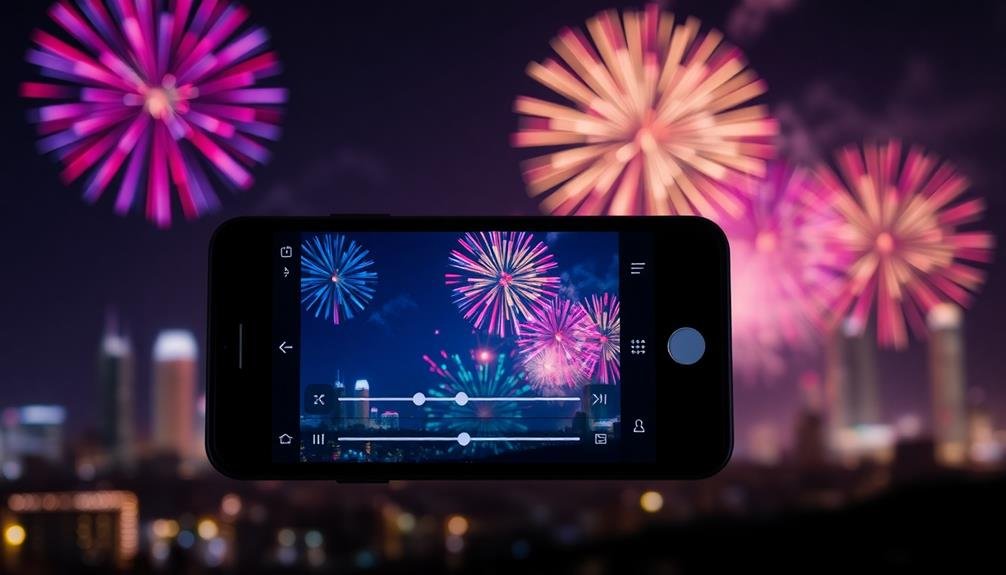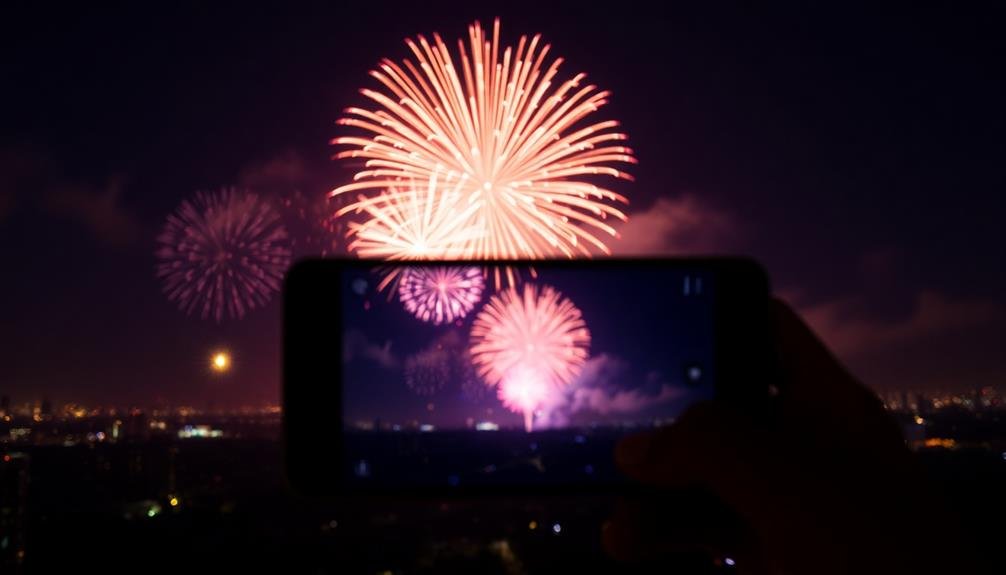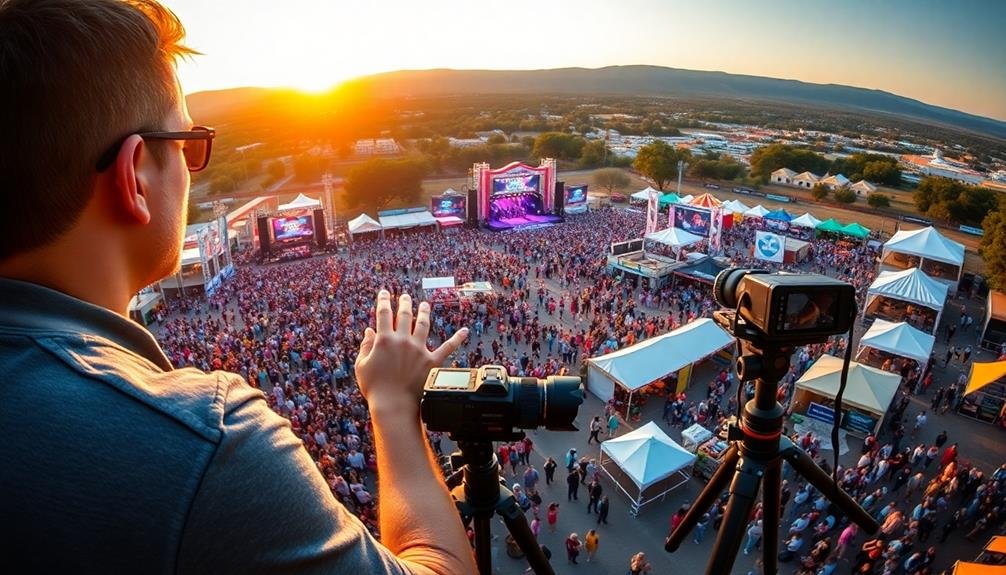Your smartphone's camera limitations can sabotage your fireworks photos. Small sensors struggle in low light, while auto-focus and fixed apertures can't keep up with the quick bursts. To capture stunning shots, master manual mode settings like low ISO, longer shutter speeds, and manual focus. Stabilize your phone using a tripod or steady surface to prevent blur. Time your shots perfectly by anticipating explosions and accounting for camera delay. Choose an elevated vantage point with a clear view and minimal light pollution. By understanding these secrets and applying key techniques, you'll unveil the potential for breathtaking fireworks imagery.
Understanding Smartphone Camera Limitations

Awareness of your smartphone camera's limitations is vital when attempting to capture fireworks. While modern phones boast impressive cameras, they're not fine-tuned for low-light, high-contrast situations like fireworks displays.
Your phone's small image sensor struggles in dim conditions, often producing grainy or blurry images. The auto-focus system may hunt for a focal point, missing significant moments. The phone's fixed aperture can't adjust for varying light levels, unlike DSLR cameras.
Smartphone cameras typically have shorter exposure times, making it challenging to capture the full arc of a firework. They also lack manual controls for shutter speed and ISO, limiting your ability to fine-tune settings for best results.
The phone's automatic white balance might misinterpret the colorful bursts, leading to inaccurate color reproduction. Dynamic range limitations can cause overexposed bright areas and underexposed dark sections in the same frame.
Lastly, digital zoom degrades image quality, so you'll need to be close to the action for clear shots.
Understanding these constraints will help you set realistic expectations and adapt your technique to maximize your phone's capabilities when photographing fireworks.
Mastering Manual Mode Settings

To truly elevate your fireworks photography, mastering manual mode settings is vital. Start by switching your phone camera to manual or pro mode. Focus on adjusting three key settings: ISO, shutter speed, and focus.
Set your ISO low, ideally between 100-400, to reduce noise and capture cleaner images. For shutter speed, opt for longer exposures, typically 2-4 seconds, to capture the full burst of fireworks. Use a tripod or stabilize your phone to prevent blur during these longer exposures.
Manual focus is essential. Set it to infinity or focus on a distant object before the show starts. This guarantees your fireworks remain sharp throughout the display.
Experiment with white balance settings to achieve the most accurate colors. Auto white balance often struggles with the intense light of fireworks.
Don't forget about composition. Use the rule of thirds to frame your shots, including interesting foreground elements if possible. Burst mode can help you capture the perfect moment, allowing you to select the best frame later.
Practice these settings before the event to familiarize yourself with your phone's capabilities. With patience and practice, you'll master manual mode and capture stunning fireworks photos.
Stabilizing Your Phone for Clarity

While mastering manual settings is key, your efforts can be undone without proper stabilization. When photographing fireworks, even the slightest movement can result in blurry images. To combat this, use a tripod or stable surface to keep your phone steady.
If you don't have a tripod, prop your phone against a wall, railing, or other fixed object. Consider using your phone's built-in timer or a remote shutter release to avoid camera shake when pressing the capture button.
If you're holding your phone, adopt a stable stance: feet shoulder-width apart, elbows tucked in, and phone held close to your body. Take a deep breath and exhale slowly as you capture the shot.
For added stability, try using your phone's burst mode. This rapid-fire approach increases your chances of capturing a sharp image.
Alternatively, invest in a phone grip or case with stabilizing features. These accessories can greatly improve your hand-held shots.
Timing Your Shots Perfectly

Fireworks burst in fleeting moments of brilliance, making timing essential for capturing stunning photos. To nail that perfect shot, you'll need to anticipate the explosion and be ready to snap at the right instant. Listen for the launch sound and watch for the rising streak of light. As soon as you see the initial burst, press the shutter button.
Many phone cameras have a slight delay, so you'll want to account for this lag. Practice your timing by taking multiple shots in quick succession. This increases your chances of catching the firework at its peak. Some phones offer burst mode or live photos, which can be incredibly useful for fireworks photography.
Here's a quick guide to help you time your shots:
| Stage | What to Look For | When to Shoot | Tips | Challenges |
|---|---|---|---|---|
| Launch | Rising streak of light | Just before peak | Listen for launch sound | Anticipating trajectory |
| Initial Burst | First spark | Immediately | Be ready to press | Reacting quickly |
| Full Bloom | Maximum expansion | At peak | Use burst mode | Capturing perfect moment |
| Falling Embers | Trails of light | As they descend | Experiment with exposure | Long exposure on phones |
| Multiple Bursts | Overlapping explosions | During simultaneous | Wide-angle lens | Balancing composition |
Choosing the Best Vantage Point

Selecting the right vantage point can make or break your fireworks photos. To capture stunning shots, you'll want to scout locations well before the show begins. Look for elevated spots that offer an unobstructed view of the sky where the fireworks will be launched. Hills, rooftops, or balconies can provide excellent perspectives.
Consider the backdrop as well. A cityscape or recognizable landmark can add depth and context to your images. However, avoid areas with bright lights that might interfere with your shot. If possible, position yourself upwind of the fireworks to minimize smoke obscuring your view.
Don't forget to account for crowds. Arrive early to secure your spot and bring a folding chair or blanket for comfort during the wait. If you're in a public viewing area, be mindful of others and avoid blocking their view with your phone or tripod.
Lastly, think about the direction of the fireworks. They typically launch from a central location, so try to align yourself with their trajectory for the best composition.
Adjusting Exposure for Bright Bursts

When capturing fireworks with your phone, you'll need to master manual exposure control for the best results.
Bright bursts can easily overwhelm your camera's auto settings, leading to overexposed shots.
While HDR mode might seem like a solution, it often struggles with fast-moving fireworks, so you're better off adjusting exposure manually.
Manual Exposure Control
Camera settings play an essential role in capturing stunning fireworks photos. When it comes to manual exposure control, you'll want to take charge of your phone's camera settings.
Start by switching to manual mode, which allows you to adjust key parameters independently. Set your ISO to a low value, around 100-200, to minimize noise in your images.
Choose a slower shutter speed, typically between 2-4 seconds, to capture the full trail of the fireworks. If your phone allows it, select a smaller aperture (higher f-number) to increase depth of field and keep more of the scene in focus.
Don't forget to lock your focus on a distant point where the fireworks will appear. This guarantees sharp images throughout your shooting session.
Experiment with different combinations of these settings to find what works best for your specific phone and the lighting conditions.
HDR Mode Limitations
Despite its popularity for everyday photography, HDR mode isn't ideal for capturing fireworks. When you're trying to photograph these brilliant displays, HDR can actually hinder your efforts. The reason lies in how HDR works: it combines multiple exposures to create a single image with a wider dynamic range. While this technique excels in static scenes, it falls short with fast-moving, bright subjects like fireworks.
Here's why HDR mode struggles with fireworks:
- Motion blur: Fireworks move quickly, and HDR's multiple exposures can result in ghosting or blurring.
- Overexposure: HDR tends to brighten shadows, which can wash out the dark sky background.
- Artificial look: The combined exposures may produce an unnatural appearance, losing the vibrancy of the fireworks.
- Slow processing: HDR takes longer to capture and process, potentially causing you to miss key moments.
Instead of relying on HDR, you'll achieve better results by manually adjusting your exposure settings. Opt for a slightly longer shutter speed to capture light trails, and experiment with lower ISO settings to maintain image quality.
Editing Tricks for Stunning Results

Once you've captured your fireworks shots, you're ready to elevate them with some editing magic.
Start by tweaking the brightness and contrast to make the bursts pop against the night sky.
Then, experiment with color filters to enhance the vibrancy, and finish by cropping your images to create the most impactful composition.
Adjust Brightness and Contrast
Brilliance can be achieved long after you've captured your fireworks photos. Adjusting brightness and contrast is an essential step in enhancing your images. These edits can transform a dull shot into a vibrant masterpiece, bringing out the true essence of the fireworks display.
Start by increasing the overall brightness to reveal hidden details in darker areas. Be careful not to overexpose the bright spots, as this can wash out the colors.
Next, boost the contrast to make the fireworks pop against the night sky. This creates a more dramatic effect and separates the bursts from the background.
For best results, follow these steps:
- Begin with subtle adjustments, increasing gradually
- Focus on enhancing the fireworks' core colors
- Pay attention to the sky's tone, maintaining a natural look
- Use selective editing to target specific areas if needed
Apply Strategic Color Filters
Strategic color filters can take your fireworks photos from good to spectacular. When applying filters, focus on enhancing the vivid colors and contrast of the fireworks against the night sky. Use warm filters to intensify reds, oranges, and golds, making the explosions appear more vibrant and energetic.
Cool filters can accentuate blues and purples, creating a dreamy, ethereal effect. Don't overdo it with filters; subtlety is key. Aim for a natural look that enhances rather than distorts the original image.
Experiment with selective color filters to make specific hues pop while muting others. This technique can create stunning visual effects, drawing the viewer's eye to particular areas of the photo.
Consider using a gradient filter to balance the exposure between the bright fireworks and the darker sky or landscape. This can help prevent overexposure of the fireworks while maintaining detail in the surrounding environment.
Black and white filters can also produce striking results, emphasizing the patterns and textures of the fireworks against a stark background. Remember to adjust the contrast and brightness after applying filters to fine-tune your image for maximum impact.
Crop for Maximum Impact
Cropping is a powerful tool that can dramatically improve your fireworks photos. After you've captured your shots, don't be afraid to trim away excess sky or ground.
Focus on the bursts themselves and remove any distracting elements that might draw attention away from the main spectacle.
When cropping your fireworks photos, consider these key points:
- Rule of thirds: Position the main bursts along the intersecting lines of a 3×3 grid for a more visually appealing composition.
- Negative space: Leave some dark areas around the fireworks to create contrast and emphasize their brilliance.
- Multiple bursts: If you've captured several explosions in one frame, crop to balance their placement and create a harmonious arrangement.
- Aspect ratio: Experiment with different aspect ratios like square or panoramic to find the most impactful presentation for your image.
Avoiding Common Fireworks Photography Mistakes

When capturing fireworks with your phone, it's easy to fall into common pitfalls that can ruin your shots. One frequent mistake is using digital zoom, which degrades image quality. Instead, move closer to the action or crop your photos later.
Another error is relying on your phone's auto mode, which often struggles with the extreme contrast of fireworks against a dark sky. Switch to manual mode or use a fireworks-specific setting if available.
Don't forget to stabilize your phone. Shaky hands lead to blurry images, so use a tripod or rest your device on a stable surface. Avoid using flash, as it won't reach the fireworks and may wash out foreground elements.
Timing is essential; don't wait for the grand finale to start shooting, as smoke can obscure later bursts.
Be mindful of your surroundings. Confirm you're not blocking others' views and respect local regulations.
Finally, resist the urge to constantly check your photos during the show. Focus on capturing the moment, and review your shots later.
Frequently Asked Questions
Can I Use Filters or Special Effects While Photographing Fireworks?
You can use filters or special effects when photographing fireworks, but it's best to be cautious. They might distort colors or blur details. Instead, focus on capturing the raw beauty of fireworks with proper camera settings and timing.
How Do I Capture Multiple Fireworks Bursts in a Single Photo?
To capture multiple fireworks bursts in one photo, you'll need to use a long exposure. Set your camera on a tripod, use a slow shutter speed (several seconds), and keep the shutter open while multiple bursts occur.
What's the Best Way to Include People or Landmarks in Fireworks Photos?
To include people or landmarks in fireworks photos, you'll want to use a tripod and long exposure. Position your subjects in the foreground, focus on them, and use a remote shutter or timer. Balance the lighting with a lower ISO.
Are There Any Safety Concerns When Photographing Fireworks With a Smartphone?
When photographing fireworks with your smartphone, you'll want to prioritize safety. Keep a safe distance, follow event guidelines, and don't use flash. Be aware of your surroundings, and never compromise your safety for a photo.
How Can I Livestream Fireworks Displays While Maintaining Good Image Quality?
You'll want to use a stable tripod and a smartphone with good low-light performance. Choose a quiet spot, use manual focus, and adjust exposure settings. Consider using an external microphone for better audio quality during your livestream.
In Summary
You've now got the tools to capture stunning fireworks photos with your smartphone. Remember to adjust your settings, stabilize your device, and time your shots carefully. Don't forget to choose the best vantage point and experiment with exposure. With practice and these tips, you'll avoid common mistakes and create impressive images. Even if you don't nail it this time, keep trying. Your perfect fireworks shot is just around the corner!





Leave a Reply